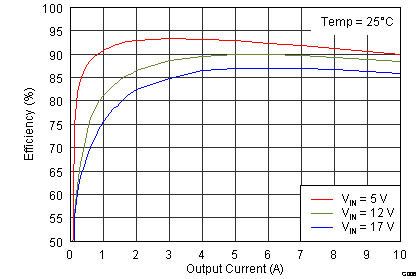SLVU777A September 2012 – November 2021 TPS54020
2.2 Efficiency
The efficiency of this EVM peaks at a load current between 3 A and 6 A and then decreases as the load current increases toward full load. Figure 2-1 shows the efficiency for the EVM at an ambient temperature of 25°C.
 Figure 2-1 EVM Efficiency at 25°C
Figure 2-1 EVM Efficiency at 25°CThe efficiency is lower at higher ambient temperatures, due to temperature variation in the drain-to-source resistance RDS_ON of the internal MOSFETs.